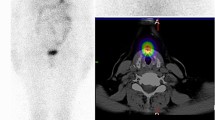Abstract
With the acknowledged problems associated with assessment of functioning thyroid mass and hence radiation dose, our policy had been to give 75 MBq iodine-131 at 6-monthly intervals to patients with Graves' disease until they became euthyroid. Since positron emission tomography (PET) has been available at this hospital, the radiation dose to the thyroid has been calculated with an accuracy of ∼20%, the thyroid mass being determined from an iodine-124 PET scan. A dose-response study has been carried out on 65 patients who have received single or cumulative radiation doses of <80 Gy. The results show that patients who receive a low radiation dose (<20 Gy) at their first treatment have a high probability of remaining toxic at 12 months. In contrast, patients who receive higher radiation doses (>40 Gy) at their first treatment have a high probability of control. The probability of becoming euthyroid increases more rapidly with increasing radiation dose than the probability of becoming hypothyroid. Following this dose-response study, a new treatment protocol has been introduced. A 124I PET tracer study prior to 131I therapy will be performed to enable a prescribed thyroid dose of 50 Gy to be delivered to patients with Graves' disease. Further 131I therapy will only be considered if patients are still toxic at 12 months.
Similar content being viewed by others
References
Hertz S, Roberts A. Application of radioactive iodine in the therapy of Graves' disease. J Clin Invest 1942; 21: 624–633.
MacDougal IR. Which therapy for Graves' hyperthyroidism in children? Nucl Med Commun 1989; 10: 855–857.
Harbert J. The thyroid. In: Harbert J, Da Rocha AFG, eds. Textbook of nuclear medicine volume II. clinical applications. Philadelphia: Lea & Febiger; 1984: 3–52.
Hardisty CA, Jones SJ, Hedley AJ, Munro DS, Bewsher PD, Weir RD. Clinical outcome and costs of care in radioiodine treatment of hyperthyroidism. J R Coll Physicians Lond 1990; 24: 36–42.
Shapiro B. Optimization of radioiodine therapy of thyrotoxicosis: what have we learned after 50 years? J Nucl Med 1993; 34: 1638–1641.
Beling B, Einhorn J. Incidence of hypothyroidism and recurrences following 131I treatment of hyperthyroidism. Acta Radiol Diagn 1961; 56: 275–288.
Nofal MM, Beierwaltes WH, Patno ME. Treatment of hyperthyroidism with sodium iodine 131I — a 16-year experience. JAMA 1966; 197: 605.
Lowdell CP, Spathis GS, Cosgrove DO, Dobbs HJ, McCready VR, Harmer CL. Low-dose 131I in treatment of Graves' disease. J R Soc Med 1985; 78: 197–202.
Hoskin PJ, McCready VR, Harmer CL, Spathis GS, Cosgrove DO. Low-dose radioiodine given six-monthly in Graves' disease. J R Soc Med 1985; 78: 893–898.
Ott RJ, Marsden PK, Flower MA, Webb S, Cherry S, McCready VR. Clinical PET with a large area MWPC PET camera (MUP-PET). Nucl Inst Med Phys Rev 1988; A269: 436–442.
Ott RJ, Batty V, Webb S, Flower MA, Leach MO, Clack R, Marsden PK, McCready VR, Bateman JE, Sharma H, Smith A. Measurement of radiation dose to the thyroid using positron emission tomography. Br J Radiol 1987; 60: 245–251.
Lambrecht RM, Sajjad M, Qureshi MA, Al-Yanbawi SJ. Production of iodine-124. J Radioanal Nucl Chem 1988; 127: 143–150.
Webb S, Ott RJ, Flower MA, Leach MO, Marsden P, McCready VR. Verification of a technique for the measurement of functioning thyroid volume using positron emission tomography. Med Biol Eng 1985; 23: 1397–1398.
Loevinger R, Budinger TT, Watson EE. MIRD primer for absorbed dose calculation. New York: Soc Nucl Med; 1991.
Rasmussen SN, Hjorth L. Determination of the thyroid volume by ultrasonic scanning. J Clin Ultrasound 1974; 2: 143–147.
Bockisch A, Jamitzky T, Derwanz R, Biersack HJ. Optimized dose planning of radioiodine therapy of benign thyroidal diseases. J Nucl Med 1993; 34: 1632–1638.
Flower MA, Irvine AT, Ott RF, Kabir F, McCready VR, Harmer CL, Sharma HL, Smith AG. Thyroid imaging using positron emission tomography — a comparison with ultrasound imaging and conventional scintigraphy in thyrotoxicosis. Br J Radiol 1990; 63: 325–330.
Diem K, Lentner C, eds. Geigy scientific tables Macclesfield UK: Geigy Pharmaceuticals; 1970: 288.
Author information
Authors and Affiliations
Rights and permissions
About this article
Cite this article
Flower, M.A., Al-Saadi, A., Harmer, C.L. et al. Dose-response study on thyrotoxic patients undergoing positron emission tomography and radioiodine therapy. Eur J Nucl Med 21, 531–536 (1994). https://doi.org/10.1007/BF00173041
Received:
Revised:
Issue Date:
DOI: https://doi.org/10.1007/BF00173041




